Hindu (Ugadi) and Christian (Roman) new year (relationship) undisclosed facts | April Fools day relationship with Hindu calendar
Namaste friends, how are you doing today? Welcome to #BhagavanBhakthi website / blog.
Bhagavan Lord Sri Krishna (Vishnu) (Rama) blessings to you and your family!
In this website / blog, you will always learn about #Hinduism #Sanskrit language.
Also subscribe to my YouTube channel from this link #BhagavanBhakthi to view videos about #Hinduism #Sanskrit language.
Just before going to “Hindu (Ugadi) and Christian (Roman) new year (relationship) undisclosed facts | April Fools day relationship with Hindu calendar“, let us know a brief, basic and very important information.
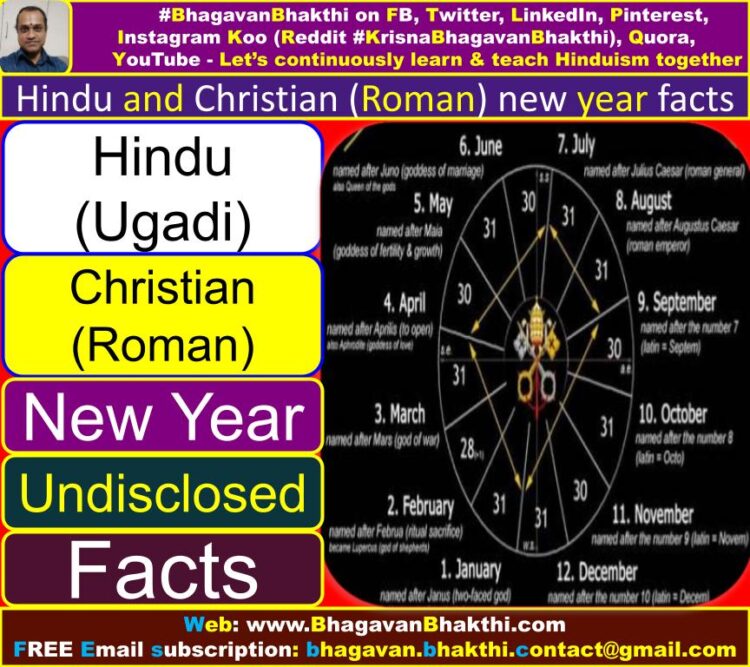
When we try to buy some vegetables or fruits, we make all types of research about it. We see whether the vegetable or fruit is fresh or not.
Whether it has been contaminated by any bacterial. Whether it has been affected by some worm or not. We make all types of detective works.
Also if we want to put our child in a school, we ask all our neighbors, our friends, our relatives about different schools. After doing heavy research we put our children into the best possible school.
Similarly if we need to take an opinion about our health we prefer going to the best doctors in the private health clinics / hospitals.

We enquire with our several friends, relatives etc. about that particular hospital and doctor. Only then after making lots of research we choose a particular hospital and a particular doctor.
When we are doing all these things: Why don’t we think about when we should celebrate the new year?
What is the meaning of the new year? Why we should celebrate the new year? Is celebrating new year on January 1st is correct or not?
How would you describe Hindu New Year? How are Christianity (Roman) and Hinduism connected? What is the other name for Hindu New Year?
What are the similarities between Hinduism and Catholicism (Roman)? What is one differences and similarities between Christianity (Roman) and Hinduism? And many more…
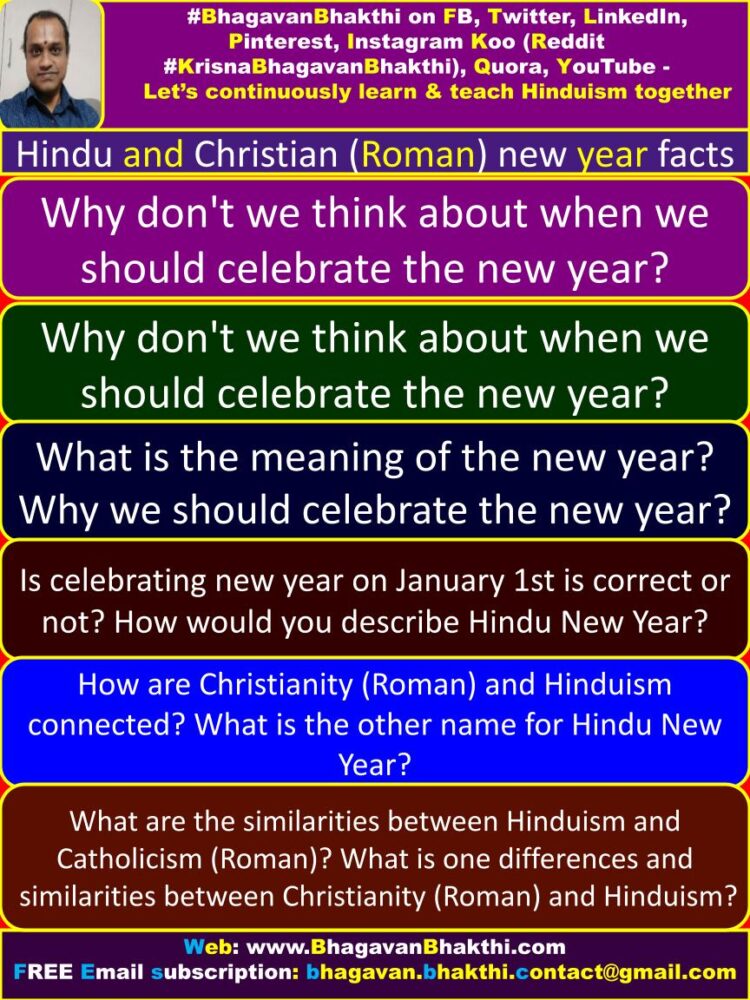
In this post (article), you will get answers to all these questions and much as given below.
Come on friends let us learn about these now as given below:
Earlier Roman (Chiristian) calendar was known as Julian calendar which had only 10 months in it as given below:
March – 1st month, April – 2nd month, May – 3rd month, June – 4th month, Quintilis (today’s July) – 5th month,
Sextilis (today’s August) – 6th month, September – 7th month, October – 8th month, November – 9th month, December – 10th month.
But later another two months (January and February) were added to make it a full year as Christians’ Easter was not coming exactly in a particular time frame.
Earlier Easter was not coming in exact (particular) month. That is, it was coming once in March, once is April, once in May and so on.
To adjust this, Europeans first tried to understand Hindu Panchanga (Hindu Almanac / calendar) and they adjusted as per Hindu Panchanga.
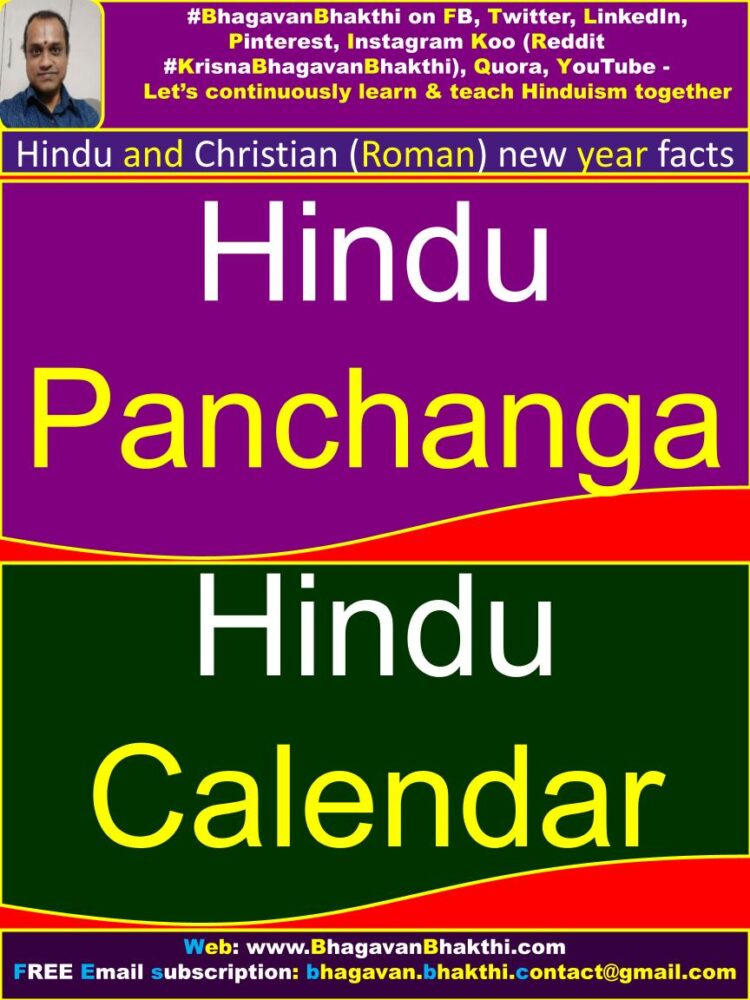
Thus a total of twelve months came into existence. This new Roman calendar is known as Gregorian calendar which was started since only around 500 years before.
(Some say it was added in some BCE year – not sure of this, but definitely months were added that is of sure).
In Julian (old calendar) calendar since it had only ten months:
In that even last six months like Quintilis (today’s July month – 5th month), Sextilis (today’s August month – 6th month), September (7th month),
October (8th month), November (9th month) and December (10th month) are pure Bharatiya (Hindu) (Indian) Sanskrit names.
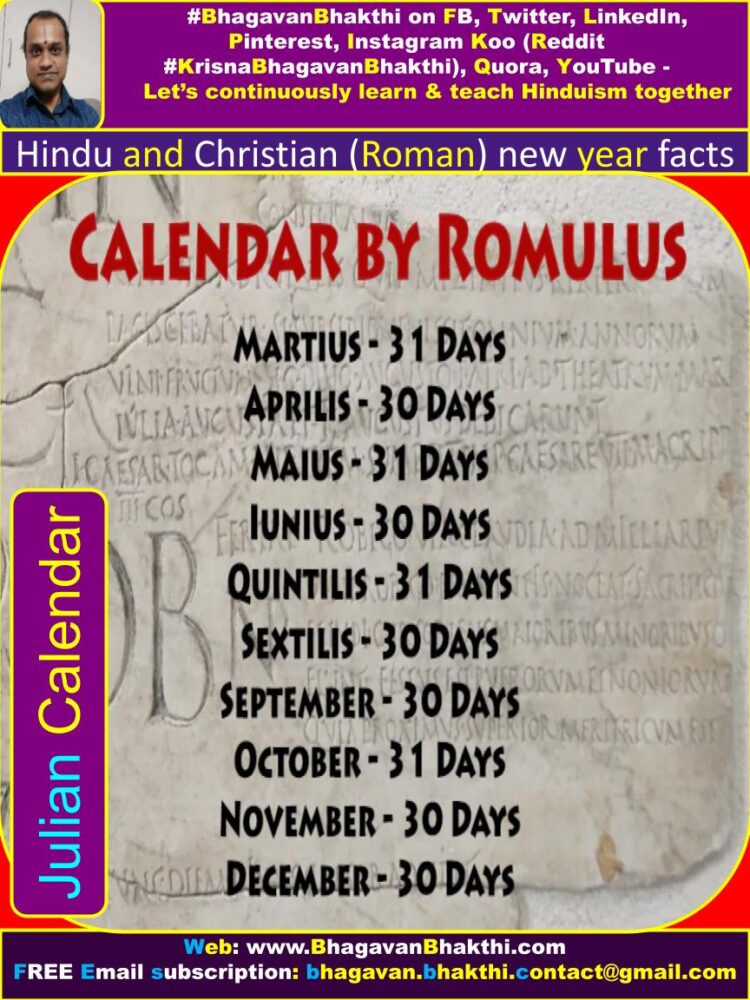
For example: Quintilis (fifth month of Julian calendar): In Samskruta / Sanskrit Pancha means 5. Here the pronunciation difference is there, means instead of Panch, the Europeans have pronounced it as Quin.
Sextilis (sixth month of Julian calendar): In Samskruta / Sanskrit Shasti or Shat means 6. Here the pronunciation difference is there, means instead of Shat, the Europeans have pronounced it as Sext (six).
September (seventh month of Julian calendar): In Samskruta / Sanskrit Sapta means 7. Again only difference is the pronunciation, instead of sapta they pronounced it as seven.
October (eighth month of Julian calendar): In Samskruta / Sanskrit Ashta means 8. Again only difference is the pronunciation, instead of ashta they pronounced it as eight.
November (ninth month of Julian calendar): In Samskruta / Sanskrit Navama means 9. Again only difference is the pronunciation, instead of navama they pronounced it as nine.
December (tenth month of Julian calendar): In Samskruta / Sanskrit Dashama means 10. Again only difference is the pronunciation, instead of Dashama they pronouncedit as ten.
Earlier, even the Europeans, westerners and others worldwide were celebrating new year during the Hindu new year called Yugadi / Ugadi which comes during the End of March or starting of April.
Thus the Europeans Heads, ordered all their followers, whoever from now onwards follows new year during the end of March or starting of April will be called as FOOLS (remember April fools day).
From that day Fools day was started to be celebrated by the Europeans.
This message is intended not to hurt or misguide people. BUT IS ONLY TO SHOW THE TRUTH AND REALITY and greatness of Hinduism (India).
Earlier, the whole world was a single entity, that is, “Vaisudhaiva Kutumbakam” (Whole world is one family).

Whole world was following the GREAT SANATANA DHARMA (HINDUISM).
But as greed for more power, fame etc. started to flow into the minds, people started to develop their own philosophies, ideas, etc.
And also we should note that this is not new thing for Bharata Vaasis (Indians).
This is been happening since unknown ages and not just 2k or 1.4k years.
Many of us must have heard the stories of Hiranyakashipu, Kamsa, Paundarika, Ravana, etc., where all these people had started their own religions and all these people had started to think they themselves are the Bhagavans (Gods).
BUT AT LAST, WE ALL KNOW WHAT HAPPENED TO ALL OF THEM.
Hinduism is called as SANATANA DHARMA and definitely Hinduism is not just an ordinary religion.
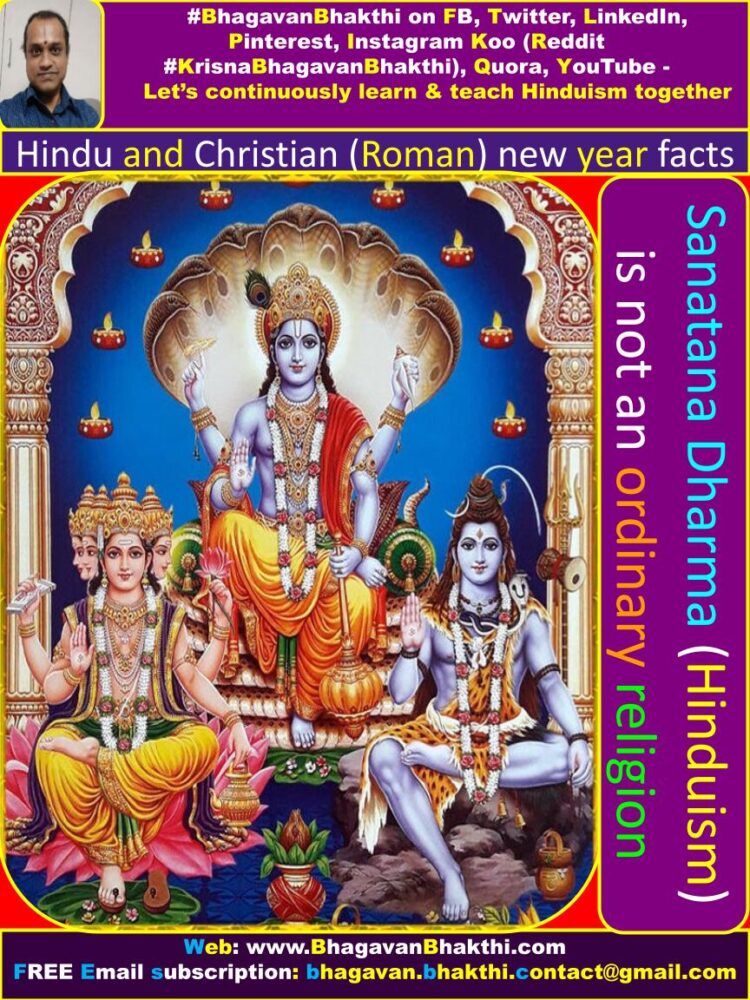
But, do you know what’s the original meaning of Sanatana Dharma is?
The opposite of orphan is Sanatana. Whoever is Sanatana Dharmi or Sanatani, he / she can never be orphaned.
And, this Great Dharma is there, from the GREAT GRAND INFINITE years, which is there in the present time, and which will remain for eternity, that is Sanatana Dharma.
(Remember, Hinduism is a cycle type of Dharma. Old things vanishes and new things takes birth.)
(Just like after human dies, he / she takes a new birth, similarly the planets, the solar systems, universes etc. etc. etc. also die and take a new birth.)
(Even Science has proved that, planets, solar system, universe, etc. dies.)
Let us understand “what is the real meaning of new year as per Hinduism (Sanatana Dharma)”:
The meaning of the new year in Hinduism is that, something new should be seen.
There should be some change in the weather, old leaves should fall and new leaves should grow, the winter season should go and summer season should start, the weather should change, there should be a happy atmosphere all around, etc.

If something new happens, then we can call it as New Year.
All these doesn’t takes place in Christian / Roman / English’s first month January, nothing changes in India or Europe or America or Africa or anywhere else in the world.
But according to the Sanatana Dharma Panchanga (Hindu Calendar), whatever is said above, they all change in our Chaitra Masam (month) (which comes at the end of March or at the starting of April).
Now you have to decide which new year is to be celebrated. Think about it seriously my dear friends.
Our Sanatana Dharma (Hinduism) is not an ordinary Dharma.
It has been started directly by the Supreme Lord Sri Vishnu (Hari / Narayana / Rama / Krishna) himself and has been carried forward by our Rishis, ancestors etc.
Now it is entirely up to us how we will take it forward.
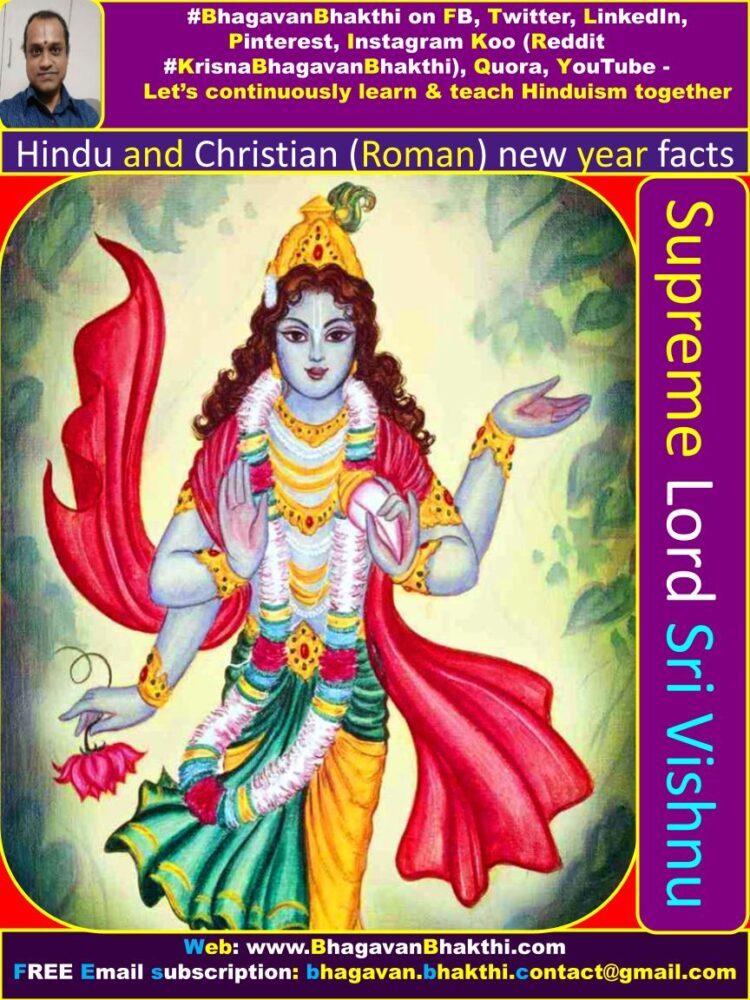
Think wisely and celebrate only the real and correct new year.
Now think my dear friends, do you still want this fools day or new year to be celebrated in our Bharatiya country (India)?
Just think again my dear friends. Think and spread this message to your well wishers all over.
This is nothing to do with one particular religion, but as a whole world we need to think before doing or celebrating something.
Now let us all know the real meaning of Hindu new year Yugadi / Ugadi as given below:
Yugadi / Ugadi, is the new year as per Hindu time element. Yugadi / Ugadi marks the beginning of the most auspicious season called Vasanta Rutu (Ritu) (Spring Season).
In this season, we find trees start to blossom with colorful flowers. All the trees will be filled with fresh green leaves.
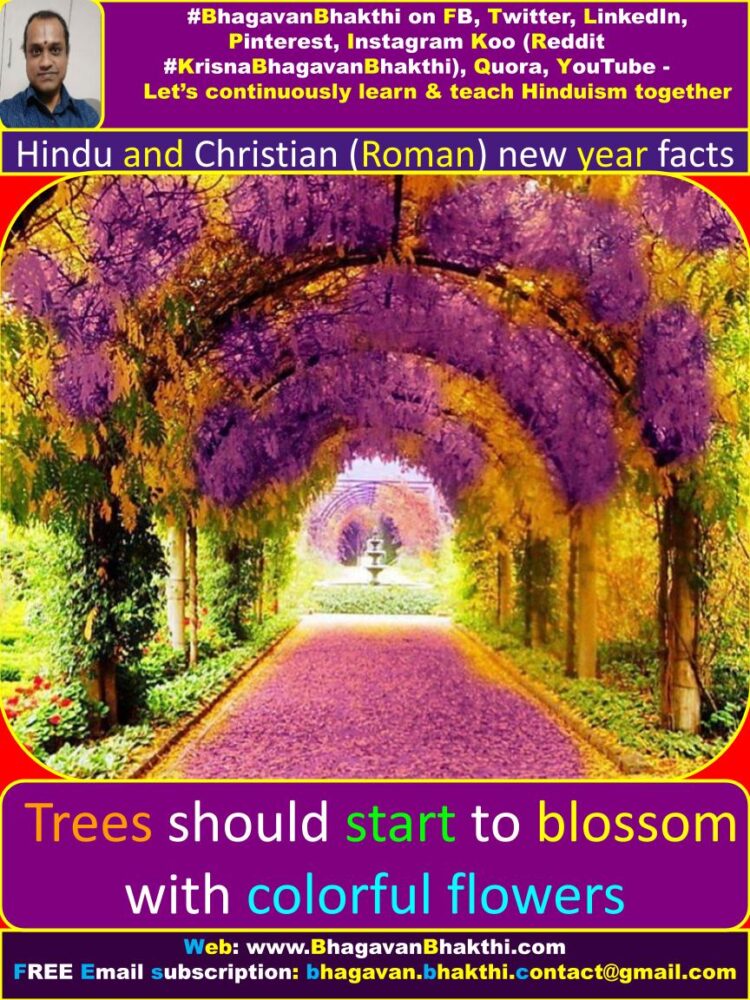
Divine smell will be emanating from the trees and many more things will be happening with the advent of the Vasanta Rutu (Ritu) (Spring Season).
Yugadi / Ugadi is one of the great names of Lord Sri Vishnu (Hari / Narayana / Rama / Krishna) himself.
Shloka #33 of Sri Vishnusahasra Nama Stotram describes Lord Sri Vishnu (Hari /Narayana / Rama / Krishna) as given below:
‘Yugadi-krit’, that is, someone who creates the Yugas | ‘Yugaavarto’, that is, someone who is the cause of the repetition of the Yugas.
Hence, it is the perfect time to celebrate this day with the worship of the Para Brahma, that is, Lord Sri Vishnu (Hari / Narayana / Rama / Krishna), who is the cause and effect of this infinite ‘Time Element‘.
As per the Hindu Chandramana Panchanga (Lunar Calendar), first day (Prathama tithi – first day) of Shukla Paksha (Bright fortnight) is Chaitra Masam (month).
[Chaitra masam (month) is the first month as per Hindu Panchanga (Calendar).]
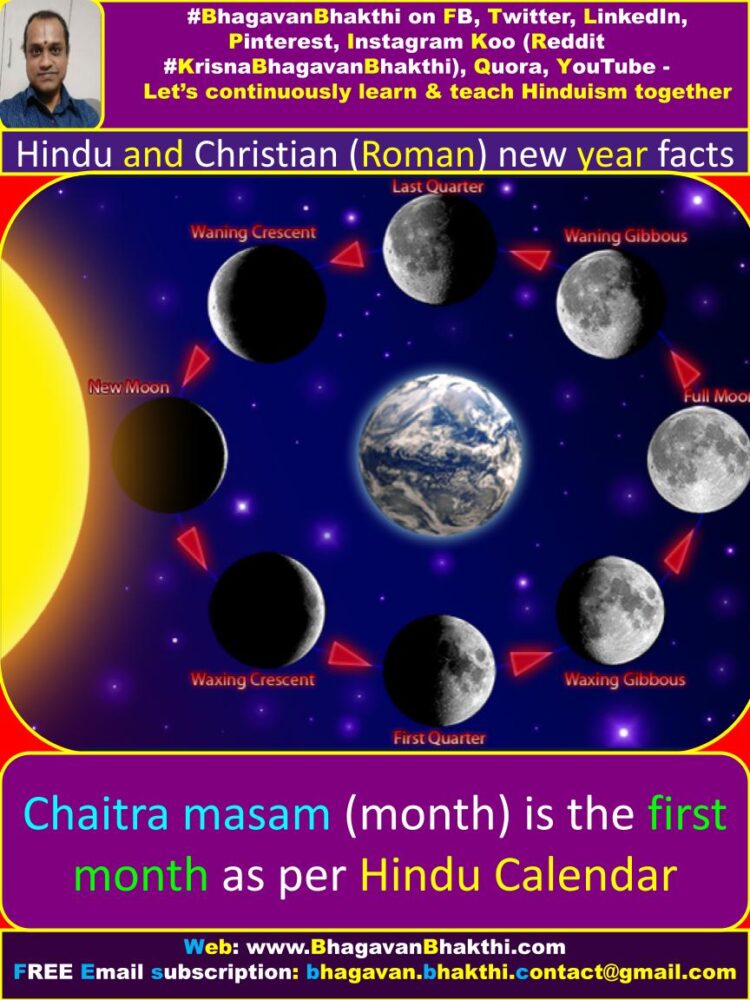
This day is considered as the day on which the Creation had started, that is, this marked the beginning of ‘Sri Sveta Varaha Kalpa‘.
This day is being referred to as Kalpaadi. (Here Kalpaadi = Kalpa + aadi = Starting of a new Kalpa.)
It is also considered as the day on which the Yuga (new era started) had commenced and hence, it is also referred to as Yugaadi or Ugadi.
[Here Yugaadi (Yugadi / Ugadi) = Yuga + aadi = Starting of a new era / Yuga.]
As per the Jyotishya / astrological (movements of the star and planets) estimates, it is said that Lord Sri Krishna’s Niryaana (leaving the earth) took place at the early hours on the ‘pratipada‘.
That is, first day of the bright fortnight as per the ‘Chandramana Panchanga‘ (Hindu Lunar Calendar) of ‘Chaitra Masam‘ (Chaitra month) corresponding to 18.02.3102 BC that marked the beginning of the Kali Yuga.
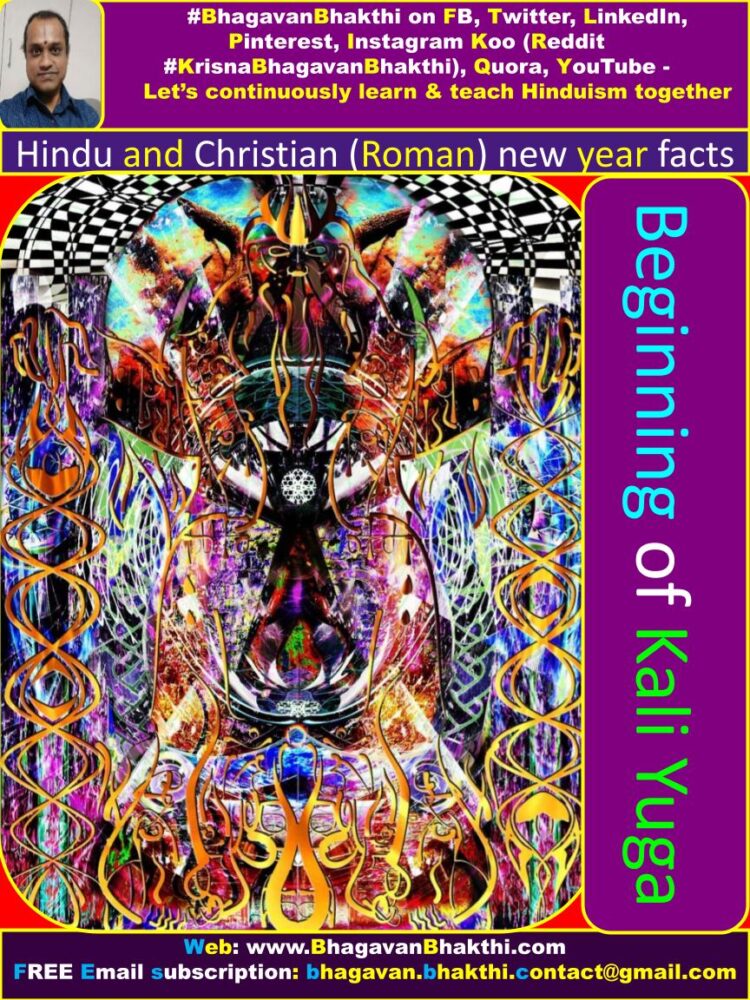
Hence, Yugadi / Ugadi may also be assumed as the starting of Kali Yuga.
In the concept of Yugadi (Ugadi), the ‘samvatsara’ (sixty year cycle) has the following names (Samvatsara) (Year name) (Totally 60 in number) :
Prabhava, Sarvajittu, Plavanga, Vibhava, Sarvadhaari, Keelaka, Shukla, Virodhi, Saumya, Pramoda,
Vikruti, Saadhaarana, Prajapati, Khara, Virodhikrit, Angeerasa, Nandana, Paridhavi, Shrimukha, Vijaya,
Pramaadee, Bhaava, Jaya, Aananda, Yuva, Manmata, Raakshasa, Dhaata, Durmukha, Nala,
Eeshwara, Hevalambi, Pingala, Bahudhaanya, Vilambi, Kaalayukthi, Pramadhi, Vikaari, Siddharthi, Vikrama,
Saarvari, Raudra, Vrusha, Plava, Durmathi, Chitrabhanu, Shubakrut, Dundubhi, Subhanu, Shobhakrut,
Rudhirodgaari, Taarana, Krodhi, Raktaakshi, Paarthiva, Vishvavasu, Krodhana, Vyaya, Paraabhava, Akshaya.
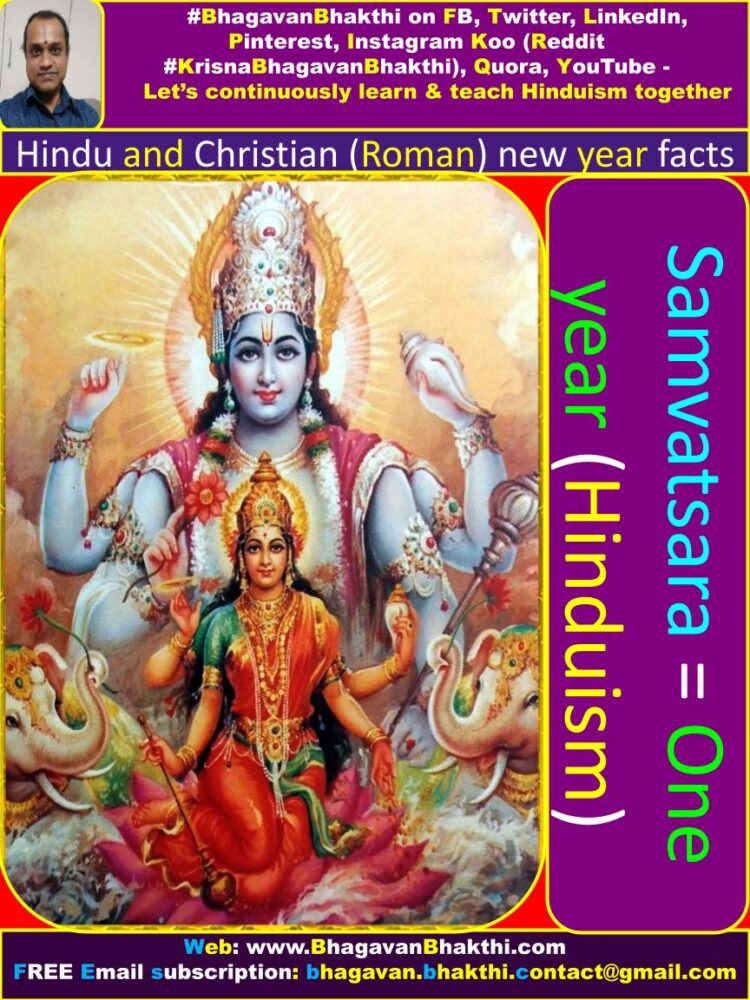
In Hinduism (Sanatana Dharma), every year has it’s own unique name as given above.
As per a popular legend, all these sixty names are said to have been related with the divine Devarshi (Sage) Narada.
Devarishi (Sage) Narada is one of the Brahma Manasa Putras, that is, son born from the mind of Lord Sri Brahma Deva).
Devarshi (Sage) Narada is a great gnani / gyani / scholar, saint and Philosopher depicted as a Divine Messenger of the ‘triloka‘ (three worlds).
In all the ‘Dharma kathas‘ (stories as per Hinduism Shastras / scriptures) we usually find Devarshi (Sage) Narada playing a pivotal role and his involvement in one way or the other is very important.
As per a legend, once upon a time Devarshi (Sage) Narada caught in the mystery of Lord Sri Vishnu‘s Maya (that is, illusion) added with a curse from Lord Sri Brahma Deva, had to become a damsel with a desire to experience the materialistic life.
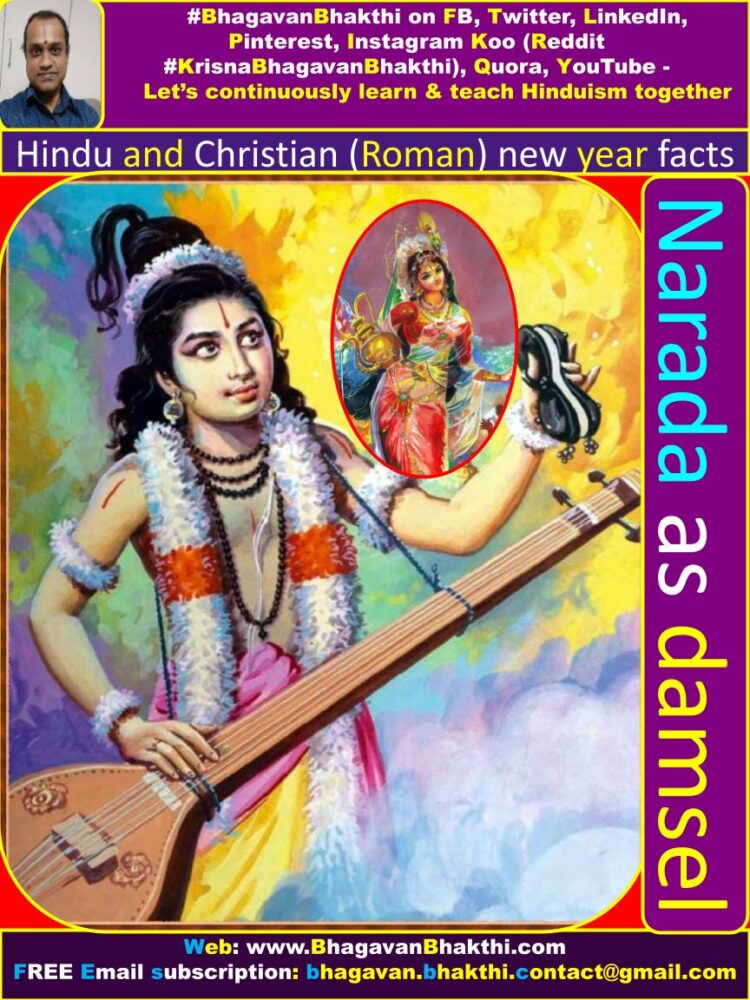
In the meanwhile, that Damsel [Devarishi (Sage) Narada] marries a Raja / King and gives birth to 60 sons.
Later, as time passes Raja / King along with his 60 sons dies in a battle.
Suddenly, the grief stricken Damsel [Devarshi (Sage) Narada)] came out of illusion with Lord Sri Vishnu‘s mercy and realized, that it was the ‘Maya‘ (illusion) of Lord Sri Maha Vishnu.
In memory of Damsel’s [Devarshi (Sage) Narada] 60 sons and to give eternity to their names, Lord Sri Vishnu blessed them that henceforth, the sixty year cycle of Hindu time element will be represented by their names.
Yugadi (Ugadi) signifies the current period, in which we are living as per the Hindu time element in a 60 year cycle, with each new year (Ugadi) denoted by an unique name starting from ‘Prabhava‘ and ending with ‘Akshaya‘.
This cycle will keep on continuing and never ends.
In few places of North India, people follow the calendar as per the ‘Vikrama Sakha‘ and accordingly the commencement of New Year differs a little bit.
There, it starts from the first day of ‘Chaitra Bahula Paksha‘ known as Baisakhi.
In Gujarat it will be from the first day of Kartika Maasam after Deepavali Amavasya.
Even in South India, where ‘Shalivahana Sakha‘ is followed, commencement of the ‘New Year‘ is observed on two different dates.
In case of Andhra Pradesh, Karnataka, Maharastra and Goa, Ugadi is observed on the first day of Shukla Paksha in ‘Chaitra Maasam‘ as per the Lunar Calendar known as Chaandramana Panchanga.
In Tamil Nadu and Kerala, Ugadi occurs as per ‘Solar Calendar‘ known as ‘Sauramana Panchanga‘, on the day when Sun enters into Mesha (Aries) Rashi which generally happen around 13th or 14th of April every year.
While it is known as Ugadi in Andhra Pradesh and Karnataka, it is called as ‘Gudi Padwa‘ in Maharastra and Goa.
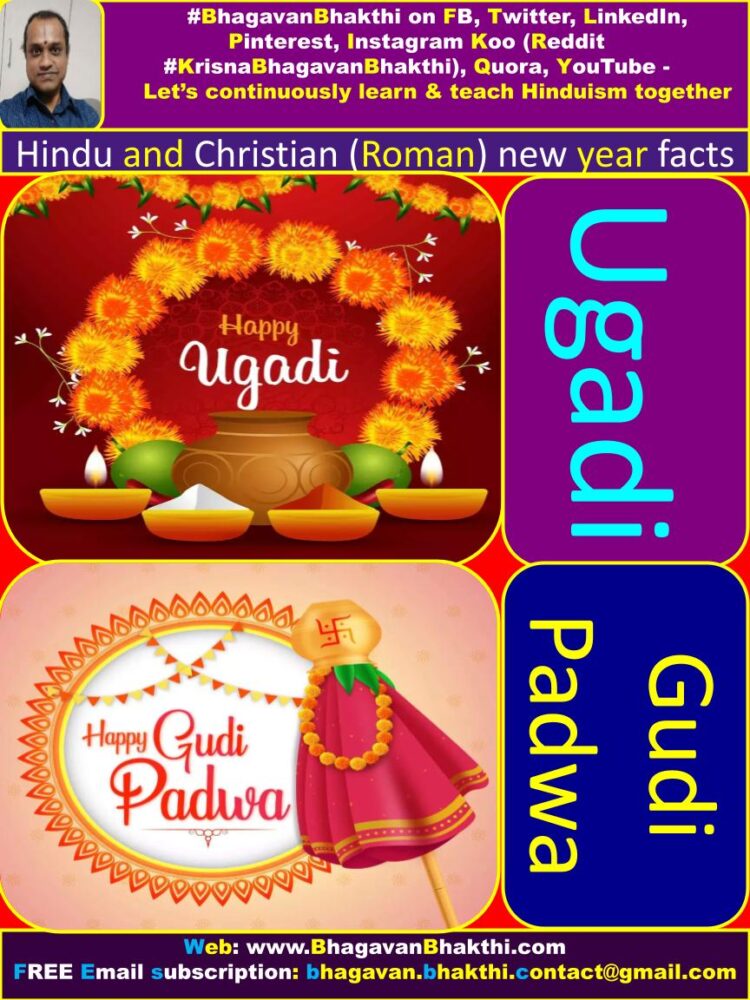
While in Tamil Nadu it is called as Puthandu festival, in Kerala it is known as Vishu festival.
Ugadi marks the beginning of nine day festival called Vasanta Navaratri, also known as Sri Rama Navaratri celebrated for a period of nine days ending with Sri Rama Navami (Avatar day of Lord Sri Rama).
It is a Hindu tradition to begin any new activity on an auspicious note, especially if it is coinciding with Ugadi.
On this particular day, it is prescribed and it is very highly meritorious to perform ‘Thailabhyanganam‘, Sun worship, ‘Nimba Kusuma Bhakshanam‘, ‘Panchanga Shravanam‘, etc.
To watch videos on #Hinduism #Sanskrit language, SUBSCRIBE to my YouTube channel from this below link:
#BhagavanBhakthi YouTube channel
Here we should note that, all the English and other countries’ words are taken by our great Sanskrit bhasha (language) itself.
To know more about, how the world’s countries names are related from Samskruta / Sanskrit words, you can visit this link for more information:
Countries names taken from Sanskrit
To know “List of English words originated from Sanskrit”, please visit the below link:
List of English words originated from Sanskrit
To know “List of Arabic words originated from Sanskrit”, please visit the below link:
List of Arabic words originated from Sanskrit
To know “List of Japanese words originated from Sanskrit”, please visit the below link:
List of Japanese words originated from Sanskrit
Dear friends, if you need any clarifications about this post, kindly let me know, I will definitely try to answer all of them.
Also your one LIKE, one COMMENT, One Share, one SUBSCRIPTION is highly important.
This will help to know the quality of this content and also it will be helpful to know if any improvements is required for the content.
If you feel this content is useful to you and has helped you to improve your knowledge, kindly share this with your well-wishers.
Because “SHARING MEANS CARING”.
For receive FREE EMAIL SUBSCRIPTION about #BhagavanBhakthi, you can send an email to bhagavan.bhakthi.contact@gmail.com from your email ID.
NAMASTE!
Sri Gurubhyo namaha
Sri Krishnaaya namaha
Sri Krishnaarpanamastu
I would like to use some of your sentences in my video to realize these westernizers. Is that okay if I use three to four of your sentences in my video?
Please do it. It's all the aashirvaadam of my Guru, Guru Paramparam and Sri Hari. We should always be thankful about the knowledge we are gaining. Do let me know about the video when you do it, as I want to learn from you too. Dhanyavaadam.
Sri Gurubhyo Namaha
Sri Krishnaaya Namaha
great info… Hare Krishna! (Hallelujah Christ)
Thanks for your valuable feedback. You can read my other posts also to better understand about the Great Sanatana Dharma. Keep in touch.
Sri Gurubhyo Namaha
Sri Krishnaaya Namaha